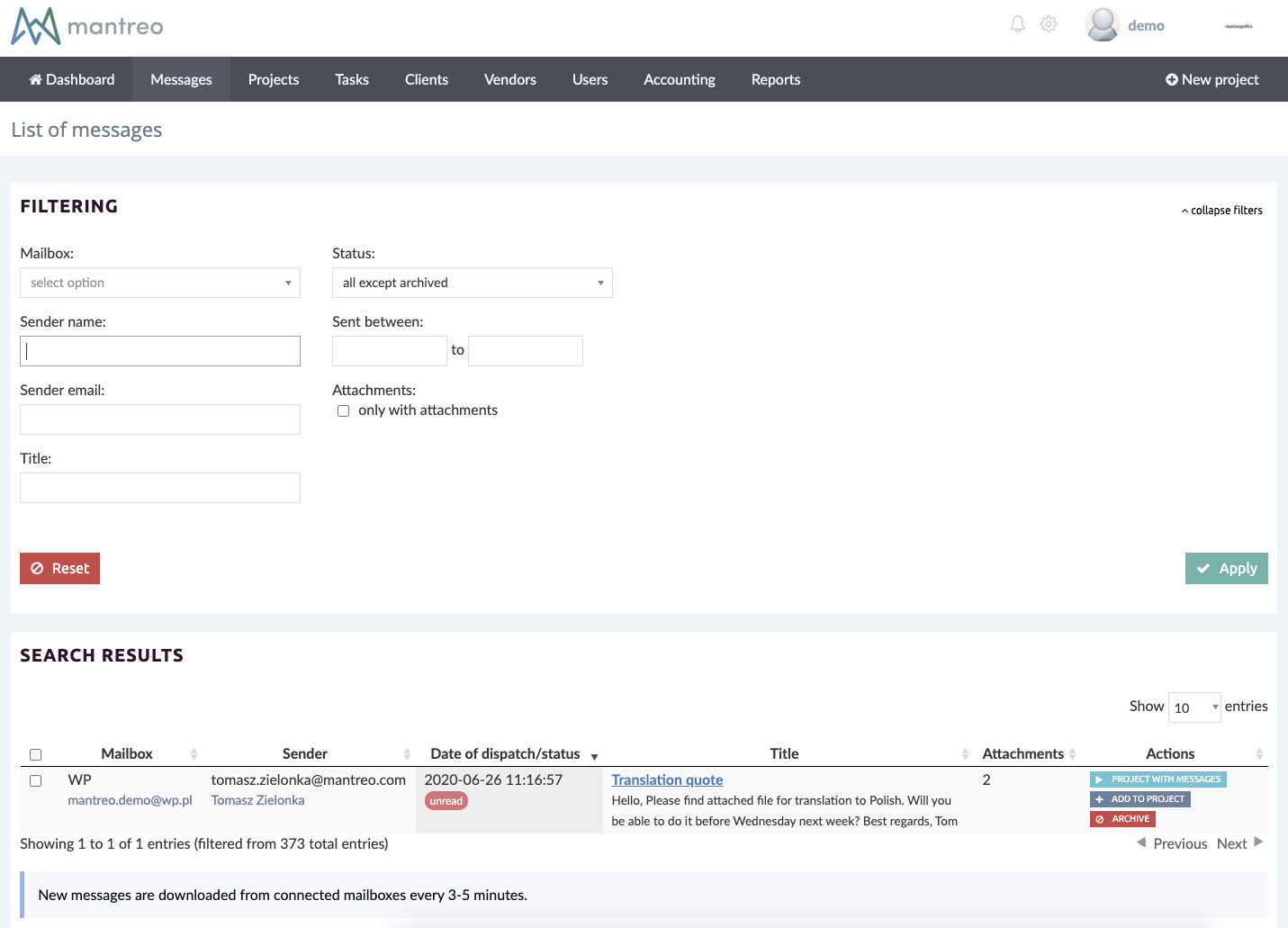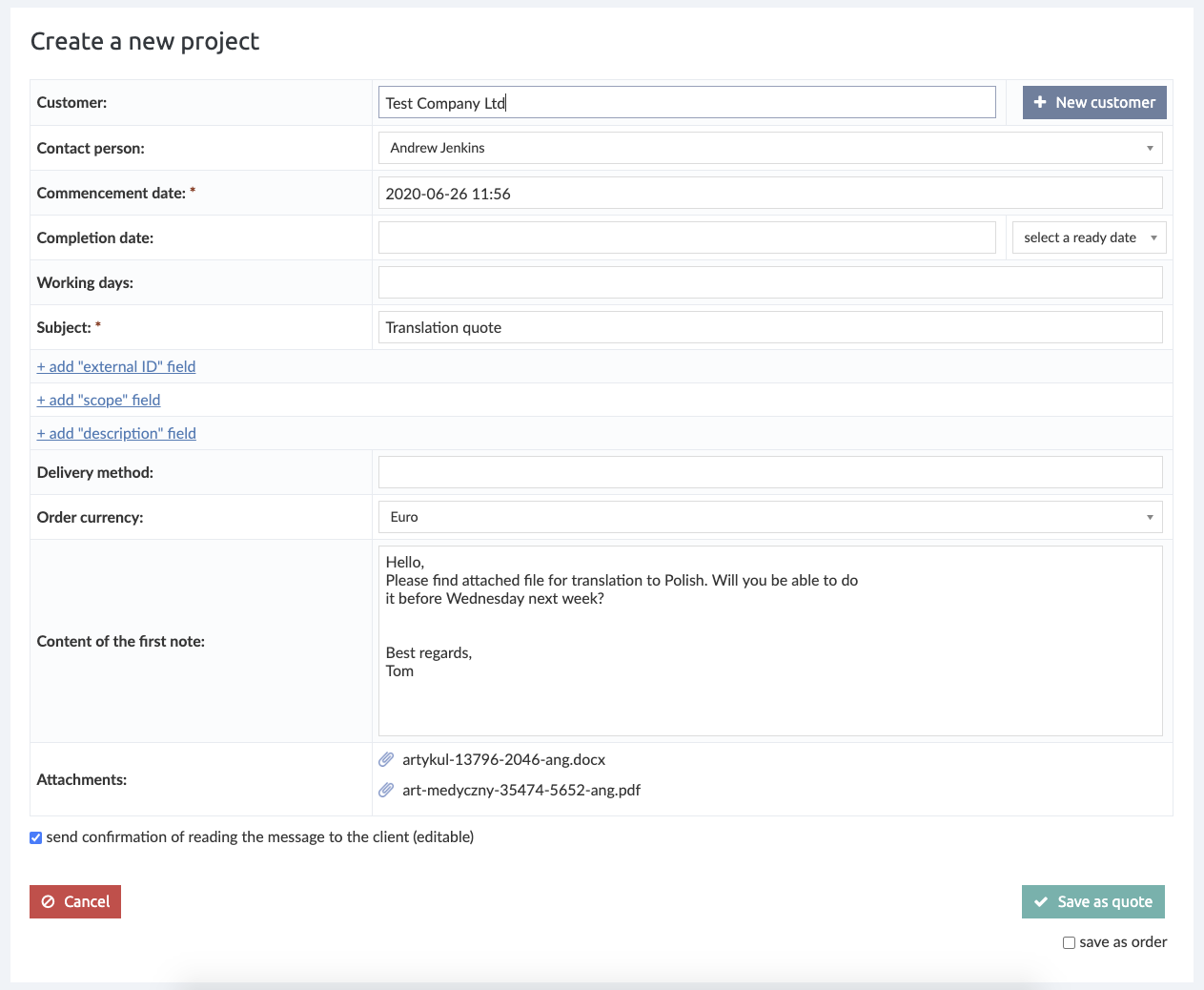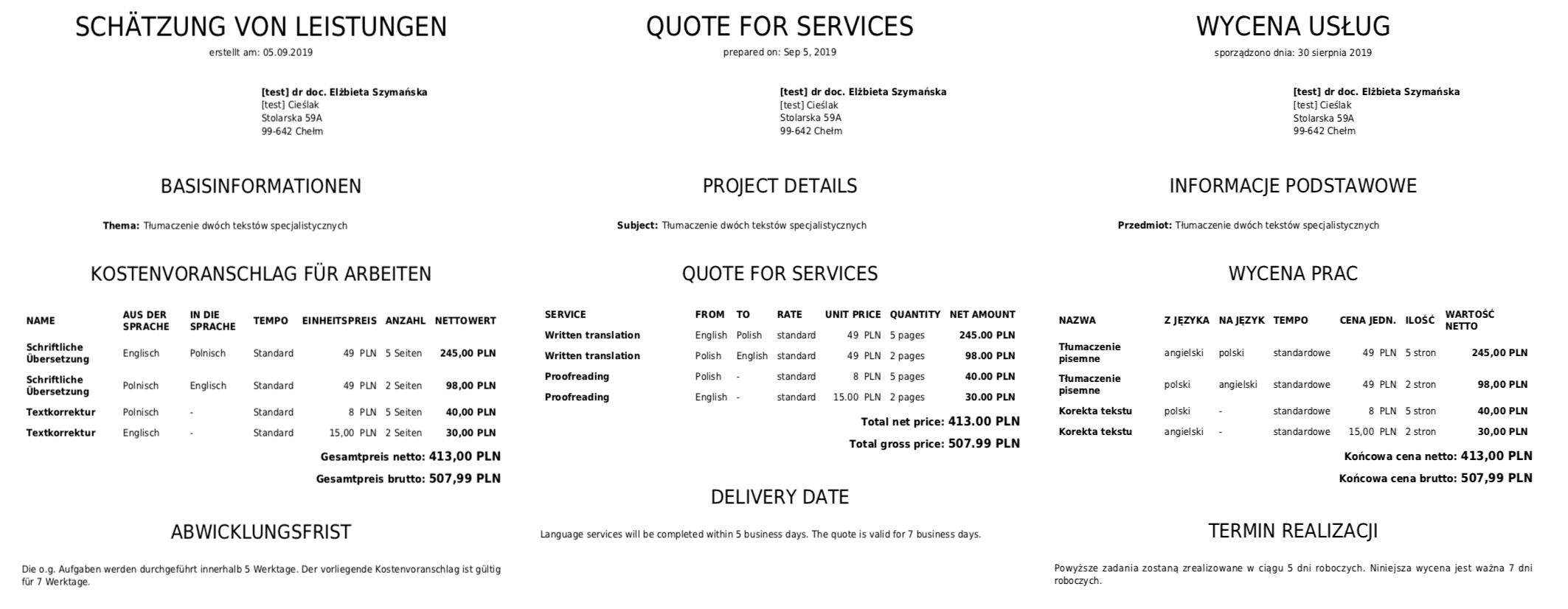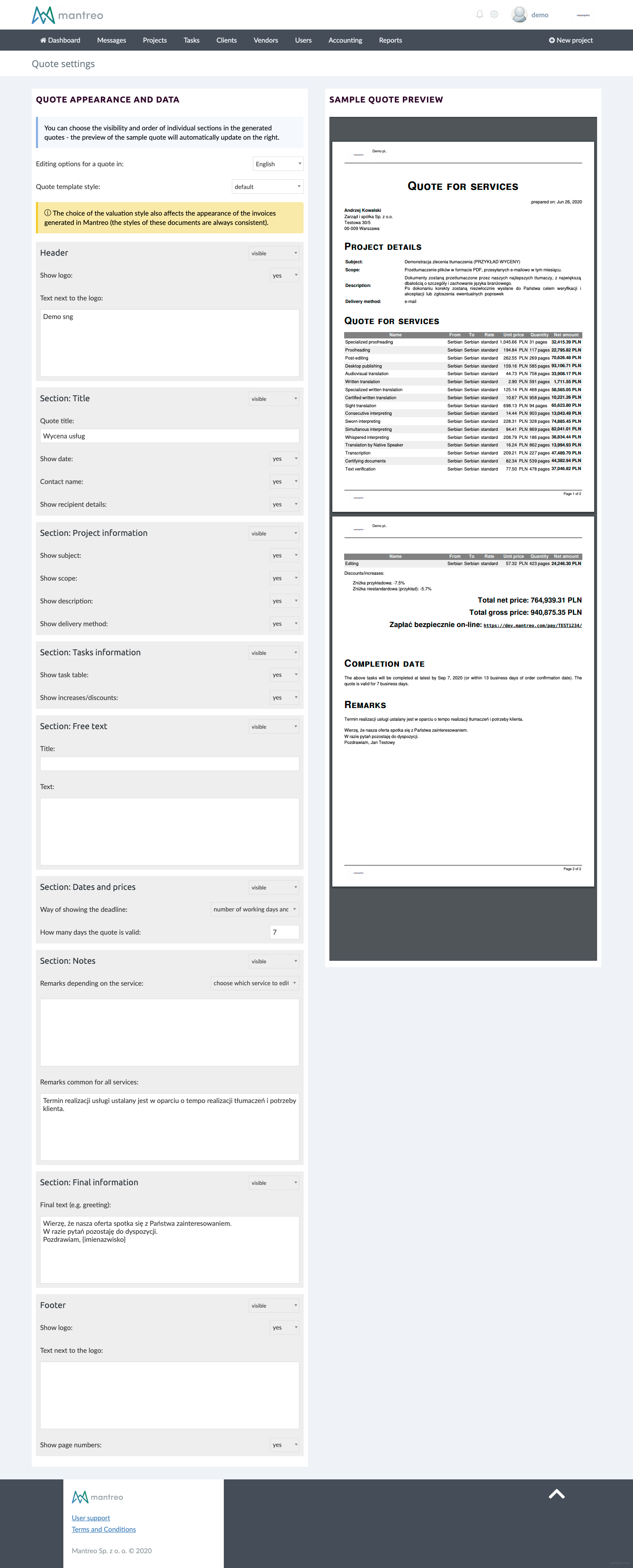
Preparing a quote in a translation agency seems like an easy task - you simply calculate the costs, add your margin and send it to the client. However, the larger the project, the more difficult it is to make a quote and the time is short. We will try to describe some unobvious ways of preparing a translation project quote that has the best chance of winning. Of course, this article will not cover all the cases, such as public tenders, for the sake of simplicity and conciseness.
What is a translation services quote?
Starting from the basics - a quote is an offer for the execution of works in which the client is interested. A quote includes:
- the sum of the costs of performing all the work ordered by the client (translations, corrections, DTP, etc.), detailing the constituents of these costs,
- the possible deadline (or deadlines for multi-stage projects) - it can be in the form of a specific date, but also in the form of business days from the date of the order or a date range.
Professional valuation also contains elements that will show the clients why they can trust a given company and present experience in similar projects (the elements of which we will discuss later).
Making a quote can often be quite difficult, especially when:
- you are dealing with different units of account - e.g. the client is billed per word, and the translator bills per page (e.g. 1800 characters with spaces);
- you have to determine the price of many tasks that are dependent on each other - e.g. when the same document needs to be translated from English into Spanish, and then into 3 other languages, after which you make proofreading for each translation and send it to the graphic designer for DTP;
- you use an individual price list or other non-standard arrangements (e.g. settlement method) for each client - this fact cannot be overlooked or the client may think we did it on purpose;
- you work for multilingual clients who pay in different currencies - it is easy to make a mistake.
When is the quote effective?
Effective pricing - not just in the translation industry - has the following four features:
- It is concise - not in terms of the length of the text, but rather the elements that the clients do not need at the moment, such as the full history of the company, team photos, all letters of reference from the last 2 years or the full text of terms and conditions (a link is enough).
- It is readable - the client should be able to notice instantly the most important information in the quote - "service, price, deadline".
- It looks professional - just as it is worth having a professional website, because it sells, it is also worth to buckle down to preparing a quote. An email with typos or a hastily formatted Word file does not make you look professional.
- It protects the interests of both parties - that is, it briefly describes what happens if the deadline for completing the order is exceeded, what the payment terms are, how additional work will be priced and how complaints are dealt with.
What does a professional quote contain?
The basic element of the valuation is visual identification - not only the logo, but also the colours and font styles should be at least similar to what the client sees at other points of contact with the brand (e.g. on the website, in advertisements).
The document should include a heading, date of valuation and the author. It should also be personalized, i.e. contain the client’s data - preferably everything we know - that is not only the name of the company, but also the name of the contact person.
Obviously, a quote should include a list of all tasks to be performed, preferably with an indication of unit prices and basic details regarding their implementation. Prices should be converted to the client’s currency - providing only the current exchange rate at the end of the document can cause the client to simply close the quote, instead of using a calculator.
The quote should leave no doubt as to what and when will be delivered to the client. It is worth describing the format of the target files (whether the formatting will be preserved or not) and their number (to eliminate any misunderstandings at this stage). The deadline for completing the tasks (or individual stages of the project) should be formulated clearly for the client, i.e. in the form of a specific date or number of working days (or both).
It is also worth describing the general terms of payment, i.e. whether the payment is made in advance or in arrears, whether the translation agency collects the deposit or what is the final date for payments. If you offer different payment methods (e.g. transfer, cash on delivery, online payment), it is also worth mentioning - it may be a bargaining chip that will convince the client to use your company's services.
To dispel any doubts, it is good to specify what exactly additional work is (not included in the quote) and how it will be valued. It is also advisable to include a link or reference to the terms and conditions or the general terms of service, or at least an indication of where these documents can be found (e.g. on the website). Each valuation of services should also include the expiry date of the offer - not only to motivate the client to act, but also to ensure they get the price stated in the quote, as it may go up after some time.
It is worth considering to include in the quote additional information that will help the client make a decision, e.g. some references from clients (in the form of short statements highlighting the most important advantages of working with your translation office), experience in similar projects or brief description of your team.
What should be the format of a quote?
It is best to send a quote for a translation project as a PDF document. This format shows professionalism and does not allow editing its content. In addition, the person who receives it can easily print it and place it on the desk of the decision maker. Of course, you can also put the quote in the content of an email or in a MS Word document, but you would lose control over the final appearance of its printout, and a PDF file printed on any printer always looks the same.
As for the content of the email in which you send the quote, it is worth repeating some information from the quote, but you certainly do not need to include them all, as there would be a risk that the client will not open the quote itself.
Typical email templates for sending quotes are presented below.
Dear Sir/Madam,
Thank you for your interest in our company's services. Please find attached the detailed quote
for the services you are seeking.
We estimate that the project will be completed by February 28, 2001, provided you confirm
the order today. If you prefer another date of project completion, please let us know.
We hope that our offer will meet your expectations. Should you have any questions or doubts,
please do not hesitate to contact us.
Yours faithfully,
John SmithDear Sir/Madam,
Please find attached the ordered quote for translation services - I hope you will
find it interesting.
We kindly ask you to confirm the order in response to this message.
Should you have any questions, please do not hesitate to contact me.
Kind Regards,
John SmithHow to quickly and easily prepare a translation project quote?
Our answer cannot be other than: use Mantreo! With us it is easy because queries from emails go straight to the program, and the entire quotation mechanism is based on templates - quote in a PDF, as well as texts in emails - everything in four different languages.

After receiving notification of a new message, just go to the "Messages" tab, where you can read it and convert it to a project.

In case of new clients, provide basic information - e.g. name, surname and company name. All attachments from the email will go straight to the project you are creating - you do not have to download and copy them.

To make a quote, you must specify what tasks need to be done. When creating translation tasks, Mantreo will automatically scan the files, indicating how many characters (including or excluding spaces) and words they contain. It will also automatically recognize the dominant language in each file. All you have to do is choose the service that the client is interested in and check if the suggested rate is appropriate.

If there are more tasks - you can add them in the same manner, and by moving the appropriate "blocks" on the Gantt chart you can set the time needed to do all the work - preferably including a safety buffer for any delays.

After entering all the tasks, just click "Generate quote" and the program will automatically prepare a PDF according to a fully editable quote template. You will send it to the client (from your own email address) with one click - all data (dates, costs, names) will be automatically replaced in the message template.

Every quote section can be moved, turned on or off and changed in the system settings at any time. And if needed, you can also correct the quote just before generating the PDF.
Automating the translation services quote
From our system's anonymous statistics we know that it takes our clients less than 7 minutes to generate a quote after receiving a query. And we know from our users directly that automating this activity allows them to eliminate many errors and mistakes, while saving lots of time. Our clients also appreciate the fact that the quotes prepared in Mantreo look professional and are legible. We invite you to set up a free trial account in Mantreo to check how all this works in practice.
Every quote is different
Of course, not every translation quote has to look like we described in this article. This is only a recommendation that can bring the highest number of accepted orders, but each translation agency can develop its own format, tailored to the individual needs and preferences of the target client. One thing is certain - it is worth automating and systematizing this process - the clients will certainly appreciate it.






Comments